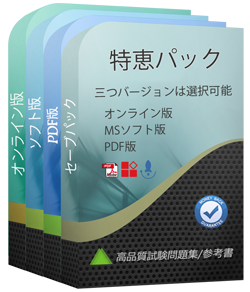あなたはNCS-Core試験参考書の更新をどのぐらいでリリースしていますか?
すべての試験参考書は常に更新されますが、固定日付には更新されません。弊社の専門チームは、試験のアップデートに十分の注意を払い、彼らは常にそれに応じてNCS-Core試験内容をアップグレードします。
Tech4Examはどんな試験参考書を提供していますか?
テストエンジン:NCS-Core試験試験エンジンは、あなた自身のデバイスにダウンロードして運行できます。インタラクティブでシミュレートされた環境でテストを行います。
PDF(テストエンジンのコピー):内容はテストエンジンと同じで、印刷をサポートしています。
割引はありますか?
我々社は顧客にいくつかの割引を提供します。 特恵には制限はありません。 弊社のサイトで定期的にチェックしてクーポンを入手することができます。
NCS-Coreテストエンジンはどのシステムに適用しますか?
オンラインテストエンジンは、WEBブラウザをベースとしたソフトウェアなので、Windows / Mac / Android / iOSなどをサポートできます。どんな電設備でも使用でき、自己ペースで練習できます。オンラインテストエンジンはオフラインの練習をサポートしていますが、前提条件は初めてインターネットで実行することです。
ソフトテストエンジンは、Java環境で運行するWindowsシステムに適用して、複数のコンピュータにインストールすることができます。
PDF版は、Adobe ReaderやFoxit Reader、Google Docsなどの読書ツールに読むことができます。
購入後、どれくらいNCS-Core試験参考書を入手できますか?
あなたは5-10分以内にNutanix NCS-Core試験参考書を付くメールを受信します。そして即時ダウンロードして勉強します。購入後にNCS-Core試験参考書を入手しないなら、すぐにメールでお問い合わせください。
更新されたNCS-Core試験参考書を得ることができ、取得方法?
はい、購入後に1年間の無料アップデートを享受できます。更新があれば、私たちのシステムは更新されたNCS-Core試験参考書をあなたのメールボックスに自動的に送ります。
あなたのテストエンジンはどのように実行しますか?
あなたのPCにダウンロードしてインストールすると、Nutanix NCS-Coreテスト問題を練習し、'練習試験'と '仮想試験'2つの異なるオプションを使用してあなたの質問と回答を確認することができます。
仮想試験 - 時間制限付きに試験問題で自分自身をテストします。
練習試験 - 試験問題を1つ1つレビューし、正解をビューします。
返金するポリシーはありますか? 失敗した場合、どうすれば返金できますか?
はい。弊社はあなたが我々の練習問題を使用して試験に合格しないと全額返金を保証します。返金プロセスは非常に簡単です:購入日から60日以内に不合格成績書を弊社に送っていいです。弊社は成績書を確認した後で、返金を行います。お金は7日以内に支払い口座に戻ります。
Nutanix Certified Services Core Infrastructure Professional 認定 NCS-Core 試験問題:
1. A consultant is not able to run the As-Built Tool for a technical reason.
What action should the consultant take to gather information and provide customer documentation?
A) Access portal.nutanix.com, search Software Documentation.
B) Create a support case on behalf of a customer.
C) Use RVTools for vSphere and Hyper-V deployments.
D) Manually create documentation using As-Built document template.
2. A consultant is setting up a new vSphere cluster. Customer requirements are as follows:
* VMs should automatically failover to another host if the host crashes
* Host CPU and Memory resources should be evenly balanced
* New VMs should be placed on the host with the most resources available Which two settings should be turned on to meet the requirements? (Choose two.)
A) vSphere Power Management
B) vShpere DRS
C) vSphere vMotion
D) vSphere HA
3. A customer would like to re-image an existing cluster. The Foundation Applet and Foundation VM is unavailable to them.
How can the consultant access Foundation-as-a-Service (FaaS)?
A) Through <cluster-IP> :9443
B) Through <CVM-IP> :9443
C) Through <cluster-IP> :8000
D) Through <CVM-IP> :8000
4. A consultant is running operational verifications to validate cluster behaviors What will happen if one power supply is disconnected from a NX-3235-G9 chassis?
A) The hardware status updates to reflect the change in Prism Element, the hosts continues to run, and the Host hardware power status alert is sent There is no impact on workloads.
B) The hosts appears disconnected in vCenter and VMs are restarting on the other hosts.
C) The hosts appears disconnected in Prism Element and VMs are restarting on the other hosts.
D) The hardware status is updated to reflect the change in Prism Element, the hosts continues to run, but VMHA has started securing workloads by moving them to other nodes.
5. A customer is running out of storage in an ESXi cluster. The customer wants to add storage without paying for an additional hypervisor license.
Which option should the consultant recommend to meet the requirement?
A) Edit the factory_config.json file to configure the node as storage-only and then expand the cluster in Prism
B) Convert the cluster to AHV to support storage-only node requirements.
C) Select the storage-only checkbox during Foundation and then expand the cluster in Prism.
D) Buy a new node to meet the requirements of the storage-only node specifications.
質問と回答:
| 質問 # 1 正解: D | 質問 # 2 正解: B、D | 質問 # 3 正解: B | 質問 # 4 正解: A | 質問 # 5 正解: B |


 クリック」
クリック」 弊社は製品に自信を持っており、面倒な製品を提供していません。
弊社は製品に自信を持っており、面倒な製品を提供していません。



 -Ruike
-Ruike

